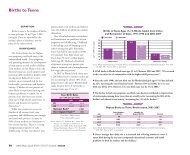2010 Rhode Island Kids Count Factbook
2010 Rhode Island Kids Count Factbook
2010 Rhode Island Kids Count Factbook
You also want an ePaper? Increase the reach of your titles
YUMPU automatically turns print PDFs into web optimized ePapers that Google loves.
80%<br />
70%<br />
School Attendance<br />
60%<br />
50%<br />
40%<br />
49%<br />
66%<br />
60%<br />
DEFINITION<br />
School attendance is the average daily<br />
attendance of public school students in<br />
each school district in <strong>Rhode</strong> <strong>Island</strong> for<br />
middle school (grades 6-8), and high<br />
school (grades 9-12).<br />
SIGNIFICANCE<br />
An important aspect of students’<br />
access to education is the amount of<br />
time actually spent in the classroom. 1<br />
Truant students are at risk of<br />
disengagement from school, academic<br />
failure and dropping out. 2 Regardless of<br />
whether absences are unexcused or<br />
excused, students who miss school are<br />
more likely to fall behind academically<br />
and engage in risky behaviors. 3,4<br />
Nationally, 3% of eighth-graders and<br />
5% of tenth-graders in the U.S. reported<br />
that they skipped three or more days of<br />
school in a four week period. 5 Students'<br />
reasons for not attending school include<br />
repeated suspensions, disruptive learning<br />
environments, poor achievement,<br />
concerns for safety, difficulty with peer<br />
and adult relationships, conflicts between<br />
school and work, family responsibilities<br />
and negative perceptions of school. 6,7<br />
Absenteeism is rarely a reflection of<br />
the student alone and is often an<br />
indication that the family needs help.<br />
Family and economic factors connected<br />
to student absenteeism include: poverty,<br />
substance abuse, domestic violence, foster<br />
care placements, student employment,<br />
student disability, single-parent<br />
households, parents with multiple jobs,<br />
lack of affordable and reliable<br />
transportation and child care. 8,9,10<br />
School factors contributing to<br />
student absenteeism include school<br />
climate, school size, attitudes of school<br />
staff and discipline polices. 11,12,13 Policies<br />
and practices to increase student<br />
attendance include: providing free<br />
breakfast and lunch in schools with<br />
low attendance rates and high<br />
concentrations of low-income students,<br />
investing in out-of-school time<br />
programs, improving the reliability of<br />
transportation to and from school,<br />
streamlining school enrollment for<br />
students in foster care, and providing<br />
psychological services. 14,15<br />
During the 2008-2009 school year,<br />
almost half (47%) of middle and high<br />
school students in <strong>Rhode</strong> <strong>Island</strong> were<br />
absent for five or fewer days. Nearly a<br />
quarter (24%) of middle school students<br />
and 33% of high school students were<br />
absent for 12 days or more. 16<br />
Attendance rates in the core cities<br />
are lower than in the remainder of the<br />
state. Improving the core cities’ high<br />
school attendance rate from the current<br />
rate of 87% to 93% (the rate in the<br />
remainder of the state) would mean<br />
that on average 890 more students<br />
would be attending high school in the<br />
core cities each day of the school year. 17<br />
30%<br />
20%<br />
10%<br />
0%<br />
1500<br />
1200<br />
900<br />
600<br />
300<br />
0<br />
28%<br />
23%<br />
Core Cities Remainder of State <strong>Rhode</strong> <strong>Island</strong><br />
Students Charged with Truancy in <strong>Rhode</strong> <strong>Island</strong> Family Court<br />
and Truancy Court, 1997-2008<br />
265<br />
Source: <strong>Rhode</strong> <strong>Island</strong> Family Court, Intake Charges, 1997-2008.<br />
◆ The U.S. Department of Education and the <strong>Rhode</strong> <strong>Island</strong> Department of Elementary<br />
and Secondary Education define truancy as 10 or more unexcused absences in a school<br />
year. 18,19 Truant students in <strong>Rhode</strong> <strong>Island</strong> may be referred by school administrators to the<br />
<strong>Rhode</strong> <strong>Island</strong> Truancy Court. The goal of the Truancy Court is to work with families,<br />
schools and communities to address the individual causes of truancy through<br />
monitoring, counseling, tutoring and other support services for students. 20<br />
◆ The number of <strong>Rhode</strong> <strong>Island</strong> students charged with truancy more than quadrupled<br />
between 1997 and 2008, from 265 students to 1,214 students. 21<br />
Effective Truancy-Reduction Strategies<br />
◆ School connectedness plays an important role in student attendance. 22 An open,<br />
supportive, safe and engaging school environment and caring adults can address<br />
many of the causes of truancy. 23,24<br />
◆ Effective truancy-reduction strategies include: creating community and school<br />
partnerships to get students to school, using challenging and creative school curricula,<br />
developing discipline policies that keep students in school, providing art, music, physical<br />
education and other high-interest classes, and implementing credit recovery programs. 25,26,27<br />
◆ Discipline policies that ensure the uniform use of suspensions and expulsions when<br />
appropriate and enable the use of alternative interventions to address the root causes of<br />
truancy and reward positive behavior are also important for reducing truancy rates. 28<br />
24%<br />
1997 1998 1999 2000 2001 2002 2003 2004 2005 2006 2007 2008<br />
9%<br />
26%<br />
14%<br />
1,214<br />
146 <strong>2010</strong> <strong>Rhode</strong> <strong>Island</strong> KIDS COUNT <strong>Factbook</strong> / Education






